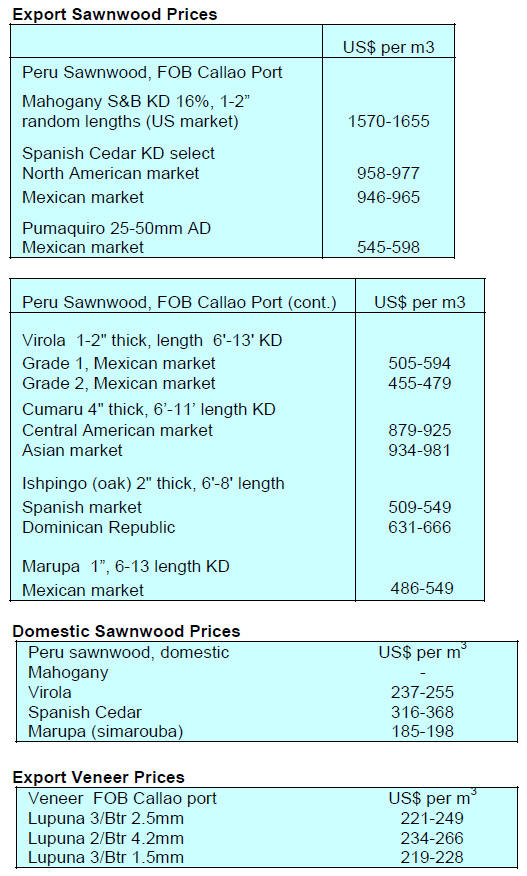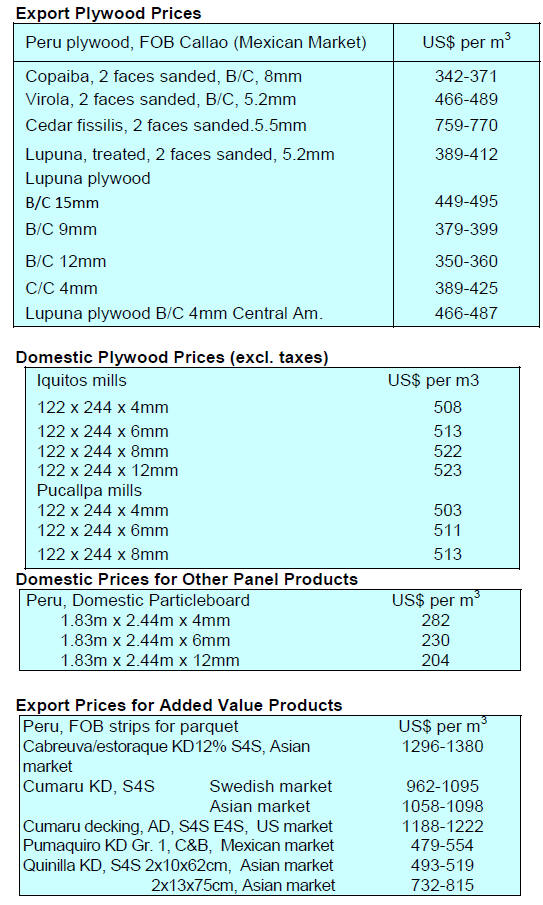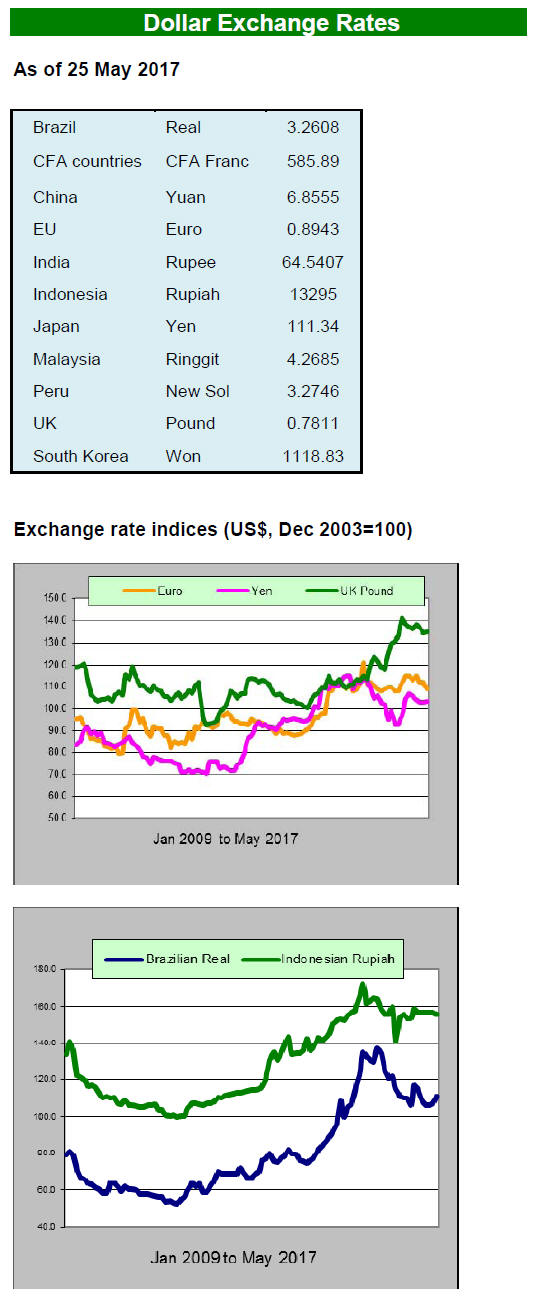2. GHANA
January exports – 6% year on year increase
Ghana’s timber and wood product exports in January 2017
amounted to 30,758 cubic metres, a 5.76% year-on-year
increase when compared to the January 2016.
During the period under review, air dried sawnwood,
mouldings and peeled veneer exports grew sharply with
the value of exports increasing by 26%, 17% and 5%
respectively.
According to the Ghana Forestry Commission, Timber
Industry Development Division (TIDD) the leading export
products in January were air-dried sawnwood (22,346
cu.m), kiln dried sawnwood (3,334 cu.m), plywood for
regional markets (1,934 cu.m), roundwood billets (1,029
cu.m) and processed mouldings (717 cu.m).
Rosewood topped the list of wood species accounting for
44% of the total exported volume along with teak (18%),
wawa (9%), papao/apa (9%) and ceiba (6%).
Asian markets were the largest importer of Ghana’s wood
products in January 2017 accounting for 78% of all
exports (China; 54%, India; 21% and Vietnam; 3%).
The high volume of rosewood exports reflects the recent
lifting of the export ban by the Forestry Commission.
2016 export performance reported
The TIDD has released export data for 2016. The report
shows that for 2016 the country earned almost Euro 225
mil. from close to 397,000 cu.m of wood products, a
significant improvement on 2015 exports.
Sawnwood, plywood, veneer, boules and kindling
accounted for most of the 2016 exports earning close to
Euro 208 mil. from a volume of 353,000 cubic metres.
In terms of the direction of trade, Asian markets accounted
for around 73% of the volume of exports in 2016 with the
top markets being China and India. These two markets
favaoured rosewood, papao/apa, teak, wawa, koto/kyere,
potrodum and gmelina. European imports from Ghana
amounted to approx. Euro 26 million or 12% of all 2016
exports.
The growing importance of Asian markets can be judged
from the graphic below showing the percentage change in
the volume of shipments to various markets for 2015 and
2016 shipments.
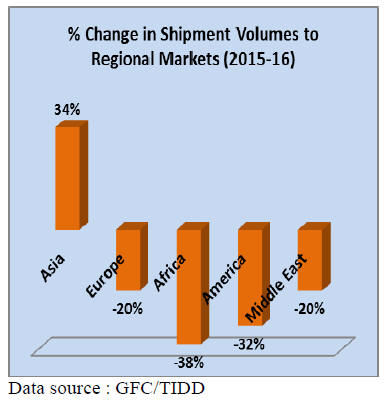
Fuelwood harvesting adds to burden on forests
The GFC has revealed that fuelwood remains an important
source domestic cooking for around 70% of Ghana’s
population.
It is estimated that fuelwood consumption could be around
16 million cubic metres annually. Fuelwood harvesting is
a heavy burden on already over harvested forests.
Ghana has a National Forest Plantations Development
Programme, part of which aims at supporting the creation
of fuelwood woodlots.
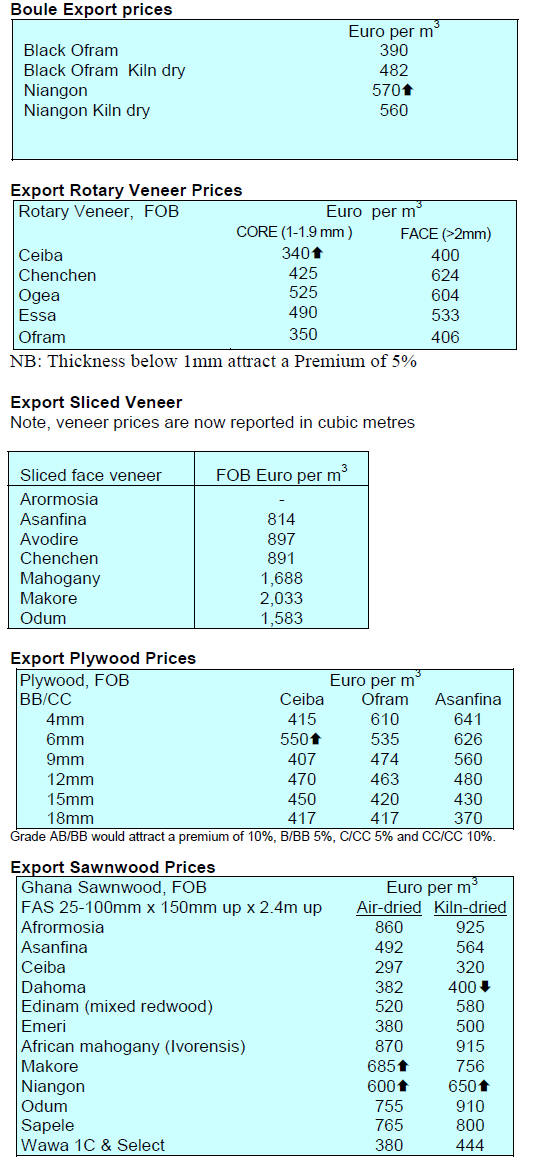
3.
SOUTH AFRICA
Warning signs that investment in
plantations is not
keeping pace with demand
Roy Southey, the Executive Director of Sawmilling South
Africa, recently spoke on the prospects for the timber
industry. The main thrust of the speech was that prospects
for the next few years look positive for the timber industry
as demand is firm and the supply adequate.
However, there are warning signs for the medium term
because the area under plantations in South Africa is not
expanding in line with the demand for structural timber
and a timber shortage is likely in the next five to six years.
Southey commented that demand for structural timber was
particularly high in the Southern and Western Cape areas.
Also, demand for transmission line poles was good as the
government continues to finance its electrification
programme. As investment in plantations slows the supply
of timber will eventually become so bad that the country
may have to import structural timbers.
The sawmilling industry is in consultation with the
government seeking to address the looming shortage of
timber, reported Southey. One immediate solution would
be for the government to grant more licenses for
plantations.
About 20 years ago restrictions were introduced on
plantation development over fears of their impact on
ground water flows. Over the years the South African
economy has grown and demand for timber has expanded
but the creation of forest resources has lagged behind.
On its part, the sawmilling industry is seeking to increase
its efficiency to try and lift recovery from the average 49%
at present. To achieve this the industry will need to invest
in advanced technologies so the industry has approached
the Department of Trade and Industry to explore how the
government might aid such a shift in production.
For more see: http://www.timber.co.za/news/article/prognosisfor-
the-timber-industry
Value of approved residential building plans dips
The Bureau for Economic Research at the Stellenbosch
University (FNB/BER) tracks a range of economic
indicators and publishes the FNB/BER Building
Confidence Index.
The latest data is for the first quarter 2017 and FNB/BER
says its Building Confidence Index improved for the third
consecutive quarter in the first quarter of 2017. FNB/BER
writes “this marks the highest confidence in more than a
year. However, despite the higher confidence, building
activity was broadly lower, especially for main
contractors”.
The data available show that in the first quarter 2017 the
value of residential building plans passed fell by almost
8% compared to the same period in 2016.
Completions in the first quarter rose but with a decline in
housing starts activity in the overall construction sector
will slow in the second quarter and possibly beyond that.
See: https://www.ber.ac.za/BER%20Documents/BER-pressrelease/?
doctypeid=1068
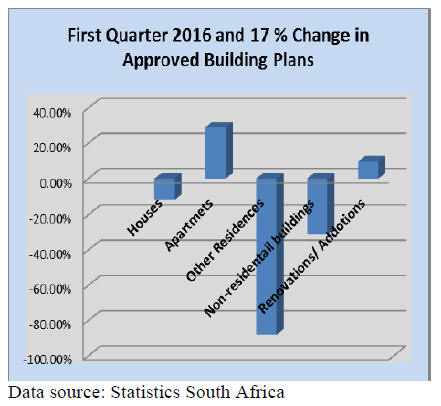
4.
MALAYSIA
MTIB transfers local licensing
authority to Sabah
Beginning 1 June this year the authority to license the
export and import of wood products in Sabah will be
transferred from the Malaysian Timber Industry Board
(MTIB) to the Sabah Forestry Department. The decision to
transfer this authority is considered a ‘historical moment’
in Sabah reversing federal control which has been in place
for 25 years. The MTIB will now concentrate on
supporting the development of downstream activities in
the state.
Rubberwood – the raw material for added value
products
The Plantation Industries and Commodities Ministry said
last year the export of wood products from Malaysia stood
at RM22.1 billion, of which Sabah contributed about
RM1.75 billion or 7.9 per cent.
Although Peninsular Malaysia harvests from the natural
forests are small, manufacturers have built a vibrant
industry around the readily available rubberwood
resources and have developed an extensive international
market for rubberwood furniture.
More protected areas in Sabah
The Sabah Forestry Department has been systematically
reclassifying much of the natural forest in the state as
Total Protected Areas (TPAs). The forests in Sabah are
rich in commercial species but now greater emphasis is on
plantations.
The Chief Conservator of Forests in Sabah said although
plantation timbers are not of the same quality as timber
extracted from natural forests they could be turned into
high quality products, adding that the pattern of industry
development in Peninsula Malaysia is likely to be repeated
in Sabah as the local plantations become ready for harvest.
Sarawak – jobs security a priority as log harvests
reduced
Sarawak Urban Planning, Land Administration and
Environment Minister, Len Talif Salleh, in speaking to the
State Assembly, said there would be a gradual reduction
and phasing out of logging activities in the natural forest.
He continued saying, the state government needs to take a
holistic approach to the issue of natural forest logging in
order to avoid any negative impact on industrial
production and job security in the state. He said the timber
industry would be given time to adjust to the new
situation.
Last year timber exports from Sarawak amounted to
RM5.95 bil. and the industry has created employment for
over 100,000 people in the state. Also last year the state
government collected RM550 mil. in royalties, premium,
levies and fees from the industry which was used to
implement development projects.
The minister reiterated that the state government would
stop issuing timber licenses on state land except for
development purposes and would continue to strengthen
enforcement against illegal logging. He said the state’s
forestry policy also included making it compulsory for
timber license holders in the Heart of Borneo
Conservation Area to obtain internationally-accepted
forest management certification to ensure good practices
and sustainability.
In addition, he said the state government planned to
gazette up to one million hectares as totally protected areas
by 2020. At the same time, he said the government was
stepping up its planted forest programme with a target of
one million hectares to be planted by 2020.
On the issue of plantations, Sarawak Chief Minister Datuk
Amar Abang Johari Tun Openg, said he was disappointed
that the timber industry has not done more to help develop
a forest plantation industry in the state.
See:http://www.thestar.com.my/news/nation/2017/05/19/abangjo-
raps-timber-firms-over-lack-of-reforestationefforts/#
2mpXWAXoztxVMiiW.99
Malaysia Agarwood Fair 2017
The harvesting and trade of agarwood (also known as
gaharu or aquilaria) in Malaysia has progressed over the
years thanks to the MTIB which oversees and monitors
agarwood plantations.
The export value of gaharu products amounted to
RM15.16 million in 2016, up 15% from the year before.
Of this, RM10.3 million was derived from the export of
agarwood products comprising wood chips and wood
blocks, while RM3.74 million came from the export of
agarwood essential oils, and the remaining RM1.12
million from agarwood pieces.
Recently, MTIB hosted the Malaysia Agarwood Fair 2017,
the first for Malaysia. A total of 10 companies producing
agarwood products ranging from wood chips and blocks,
oudh perfume, tea and other products participated in the
fair.
Plywood export prices
Plywood traders in Sarawak reported mid-May export
prices as follows:
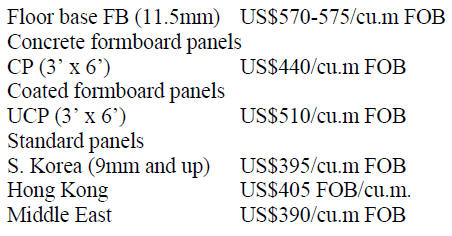
5. INDONESIA
Indonesian furniture warehouse in LA
At the opening in Los Angeles of a new warehouse by an
Indonesian furniture manufacturer, Umar Hadi, Consul
General of Indonesia, complemented the Indonesian
company saying demand for furniture products in the US
is expected to continue increasing around 3-4% per year.

Data from the US Department of Commerce for 2016
shows that on the west coast of the US Indonesia's
furniture exports enter through Los Angeles and San
Diego Ports.
Coordination of efforts to boost furniture and
handicraft sectors
The Director General of Agro Industry, Panggah Susanto,
said the government is determined to support development
of the furniture and handicraft industries and is working to
strengthen coordination between the various ministries
involved. Priority is being given to ensure raw materials
are available, promoting exports and encouraging
investment.
Panggah reported that his ministry had asked the
Minister
of Agriculture to exclude furniture samples from the
quarantine process.
In related news, the Ministry of Industry has adopted a
target for furniture exports of US$3.5 billion by 2019.
Currently, Indonesian furniture exports are around US$1.5
billion. According to the Director General of Small and
Medium Industries of Ministry of Industry, Gati
Wibawaningsih, the government’s efforts include support
to improve SME productivity, accessing raw material
needs and assistance in the import appropriate
technologies if not available locally.
Government/private sector effort needed in
conservation programmes
The Director General of Social Forestry and
Environmental Partnership, Hadi Daryanto, (Ministry of
Environment and Forestry) has said forest restoration
programmes would benefit from multi-stakeholder
approach.
He called for a new approach to implementing landscape
conservation and restoration programmes saying they
should be designed to involve government, the private
sector and civil society stakeholders.
Hadi emphasised that progress would be ensured if both
government and private sector could direct resources to
conservation and restoration efforts.
See: http://ekonomi.metrotvnews.com/mikro/gNQlld5Krestorasi-
hutan-butuh-kemitraan-multipihak
Pleas to revise peatland regulation
Businessmen and the Ministry of Industry have urged the
Indonesian President to revoke or revise regulation No.57
2016 on the Protection and Management of Peat
Ecosystems.
The Indonesian Forest Entrepreneurs Association (APHI)
of the Riau Regional Commissioners say the current
regulation threatens the viability of the industrial timber
plantation industry and has a negative impact on rural
economies.
The Ministry of Industry, in its approach to the President,
said the regulation as it now stands will negatively impact
the paper and palm oil industries because both industries
use timber raw materials from peatland areas.
Forest Moratorium extended
The Indonesian President has approved a two-year
extension to a moratorium on issuing new licenses over
land designated as primary forest and peatland.
This latest extension of the moratorium is the third
following the initial one in 2011 under the previous
administration of President Susilo Bambang Yudhoyono.
The decision to extend the moratorium is partly in an
effort to reduce emissions from fires during land clearing.
The government's forest moratorium covers an area of
around 65 million hectares.

6. MYANMAR
Third party verification for Myanmar MLAS
The Myanmar Forrest certification Committee MFCC) is
inviting agencies capable of providing third party
verification services in respect of the Myanmar timber
legality system. The credibility of the MFCC has been
called into question by civil society groups.
To reassure the international market the Forestry
department has banned the export of wood products made
from the confiscated logs, logs from conversion and logs
from conflict areas.
Barber Cho, Secretary of MFCC said that the creation of a
‘Focal Group’ and the setting up a system for third party
verification of the Myanmar Timber Legality Assurance
System (MTLAS)is a vital first step in regaining the
confidence of the international markets.
A recent review of the MTLAS determined that greater
public consultation was needed and that there was a need
for independent monitoring, both issues are being
addressed.
MTE sales in only US Dollars – no sales in Kyats
The Myanma Timber Enterprise (MTE) Export Marketing
and Milling Departments has concluded its recent sale at
which some 3,200 tons of teak logs, 366 tons of teak
sawnwood and 1,870 tons of other hardwood logs were on
offer.
At the same time they offered around 5,700 tons of teak
and other hardwoods logs under the tender system. Sales
through both systems had to be in US dollars.
Previously the Local Marketing and Milling of the MTE
conducted business in local currency but that is no longer
the case.
The Forestry Department has declared that all logs
to be
processed for export must be paid for in US Dollars not
Kyats.
Local conventions at odds with HS coding
Myanmar's Ministry of Natural Resources and
Environmental Conservation (MONREC) has issued an
order that all timber must be assigned a HS code within
HS 44.07 this code includes rough-sawn timber –under
domestic industry practice.
This, say local analysts, can include sawnwood (also
called conversion timber). It can also include squares,
posts, flitches, board, scantlings and flitches.
The domestic millers are not clear how this will mirror
items in the definition of ‘Special Commodity’ which will
attract an export tax.
Analysts point out that under the special commodity tax
sawn timber (either rough sawn or not) the tax is
structured to affect only large sawn baulks, i.e. if the
square section is 12 inches or more.

It will be seen that the average price of the
highest grade
of logs was below that of the second highest grade. This is
not the first time this has happened and reflects the
different assessment of the quality of the logs in the parcel
by the MTE and the commercial buyers.
7. INDIA
Businesses look for interest rate cut
The government has reported that inflation in April eased
to 3% and analysts say that as the monsoon is expected to
be normal and because grain production in 2016-17 was
satisfactory, inflation can be held in check this year. The
private sector is hoping that this will encourage the
Reserve Bank of India (RBI) to lower interest rates.
Wood product price indices
A press release from the Office of the Economic Adviser
to the Indian government has announced changes to the
Wholesale Price Indices report.
The Indian government periodically reviews and revises
the base year and range of products included to improve
the quality, coverage and representativeness of the indices.
As a result of the recent changes new indicative timber
sector indices will be reported to replace the previously
reported wood products and plywood indices.
The press release can be found at:
http://eaindustry.nic.in/uploaded_files/Press_Release.pdf

CITES and India’s Dalbergia sissoo
Export certification of India’s rosewood (Dalbergia
sissoo) is presently managed by CITES India which
operates within the Wildlife Section of Ministry of
Environment and Forests. Traders report that international
buyers are satisfied that certification is provided by CITES
through a department of government.
Fears had been expressed that India’s export of rosewood
musical instrument parts and handicrafts could be
disrupted but now business has returned to normal.
Notwithstanding this exporters contend that, given the
abundant and well managed sources of Indian Dalbergia, it
should not be included in the CITES listing.
Home building plan will require huge volumes of wood
products
The international brokerage firm CLSA
(https://www.clsa.com/), in a recent report, said the Indian
government’s plan to build homes for all Indians could
generate business worth over US$1 trillion.
The government’s plan calls for around 60 million homes
to be built between 2018 and 2024, most of which will be
included in the ‘affordable housing programme’ and will
require huge volumes of plywood and other wood
products.
An investment of this size, says the CLSA report, could
create over 2 million jobs annually and add nearly 1% to
GDP.
For more see: https://qz.com/979059/indias-economy-is-set-fora-
1-3-trillion-bonanza-from-60-million-new-homes/
Madhya Pradesh teak and hardwood auctions
The teak logs auctioned in depots in Madhya Pradesh
come mainly in 2 to 5 metre lengths and mostly of girths
120 cms and below.
Madhya Pradesh teak logs have good form (cylindrical
like pencils) and the wood has a golden colour with black
stripes.
The latest Madhya Pradesh auctions were held at Harda,
Jabalpur, Hoshangabad and Betul division depots and over
10,000 cubic metres of teak logs and appoximately 7,000
cubic metres non-teak hardwoods were sold.
Buyers were mostly from local mills plus some merchants
from Gujarat, Maharashtra, Rajasthan and South India.
Price indications for the Madhya Pradesh auctions are
shown below.
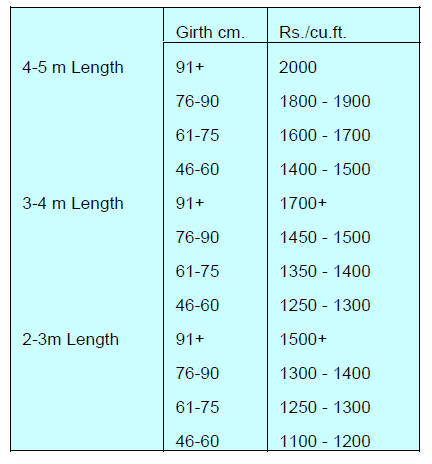
Good quality non-teak hardwood logs attracted good
prices. Logs of 3 to 4m length having girths 91 cms & up
of haldu (Adina cordifolia), laurel (Terminalia tomentosa),
kalam (Mitragyna parviflora) and Pterocarpus marsupium,
fetched around Rs.700 to 750 per cu.ft . Second quality
log prices were in the region of Rs.350 to 500 per cu.ft
while the lowest quality logs attracted offers between
Rs.200 to 300 per cu.ft.
WPC production comes to India
The Indian press is reporting that Reliance Industries
(RIL) has concluded an agreement with Germany’s
Resysta International providing for the exclusive rights for
production and marketing in India of a wood polymer
composite (WPC) ‘RelWood’.
See:
http://www.business-standard.com/content/b2b-plasticspolymers/
reliance-partners-with-germany-s-resysta-for-woodcomposite-
technology-117042700253_1.html
and
http://www.thehindu.com/business/ril-partners-with-germanysresysta-
to-bring-innovative-wood-alternative-inindia/
article18226498.ece
Wood Plastic Composites (WPCs) are produced by
combining ground wood particles and
heated thermoplastic resin.
The Indian Business Standard article on the latest
development says around half of current demand for
WPCs in India is met by imports from China and the
market for WPC products has been growing at around
15% per year for the past 5 years.
Imports of plantation teak
Prices for imported planation teak have not changed over
the past two weeks.
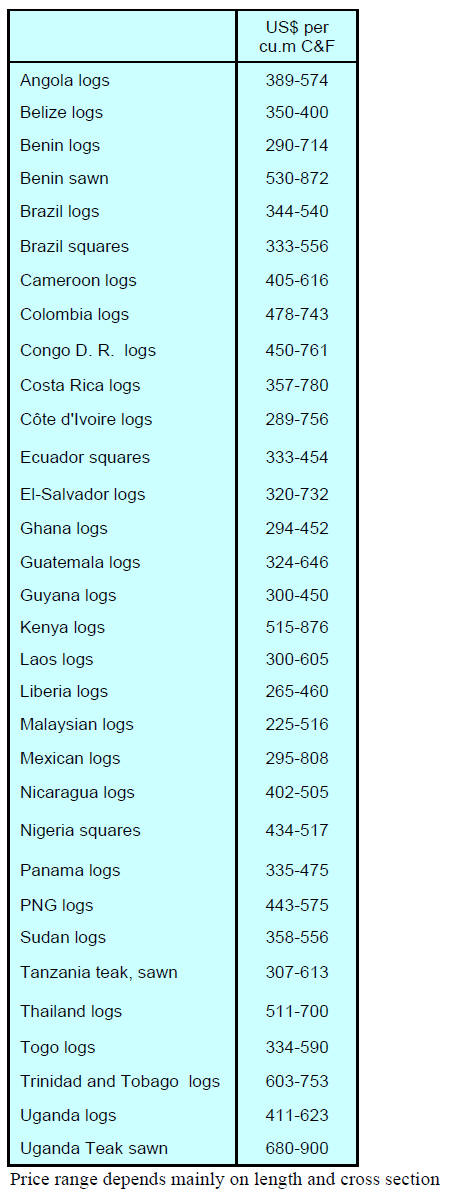
Imported sawn hardwood prices
Prices for sawnwood milled domestically remain
unchanged.
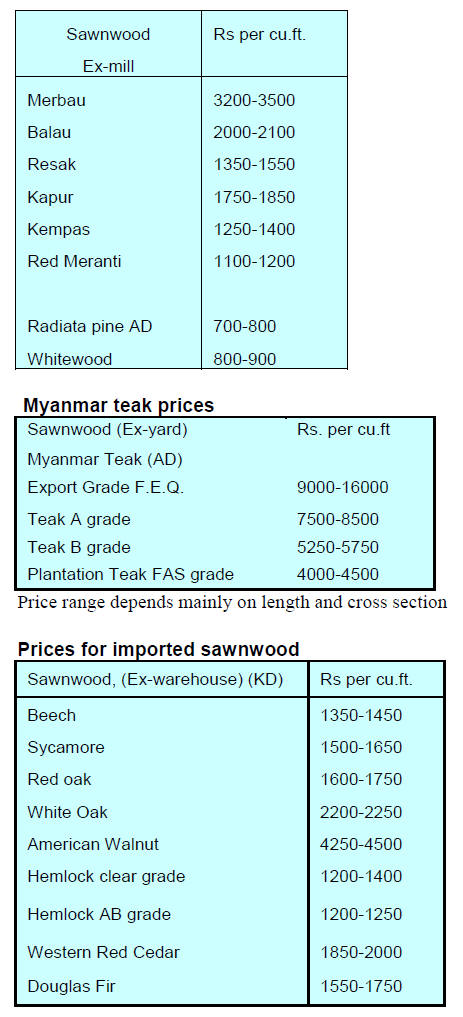
Prices for WBP marine grade manufactured by
domestic mills
Analysts expect plywood prices to rise further in the
coming months.
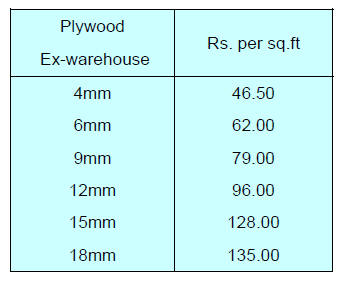
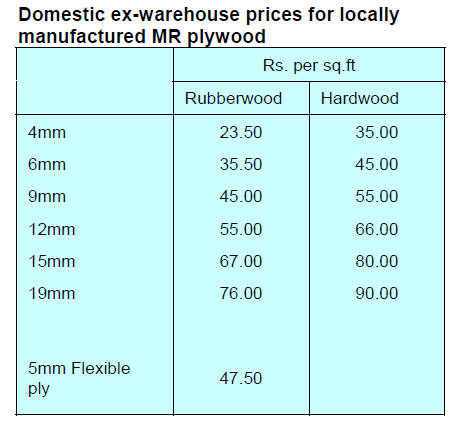
8. BRAZIL
Recession drives down inflation
The annualised inflation rate in Brazil dipped below 4% in
mid-May, the lowest for around 10 years. This is widely
expected to lead the Central Bank to cut interest rates.
Inflation has fallen from a high of almost 11% in January
last year to below the government's target. The sudden
turn-around is largely the result of the recession in Brazil
which has resulted in unprecedented unemployment and
weak consumer demand. If the low inflation holds the
Central Bank is expected to cut interest rates.
Amapá will have a system to control forest products
On May 16, the Forest Institute of Amapá State (IEF) met
to discuss the establishment of a Working Group that
would deal with forestry issues in the state of Amapá, in
the Amazon region.
One of the aims of the group is the improvement of the
timber tracking system in the state, part of the National
System for Control of Forest Products Origin
(SINAFLOR) that was developed by the Brazilian Institute
for Environment and Renewable Natural Resources
(IBAMA). Improvements planned will upgrade the system
to offer greater transparency.
The SINAFLOR system tracks the origin of timber,
charcoal and other forest products. Monitoring is done
from logging permits to transportation, storage, processing
and export. The improved system in Amapá State will be
phased in and should be fully operational by January 2018.
Export update
In April 2017 Brazilian exports of wood products (except
pulp and paper) increased 16% in value compared to April
2016, from US$190.5 million to US$221.0 million.
The value of pine sawnwood exports increased 37%
between April 2016 (US$28.0 million) and April 2017
(US$38.3 million). In volume terms, exports increased
25% over the same period, from 149,800 cu.m to 187,700
cu.m.
However, tropical sawnwood exports dropped just
over
11% from 35,000 cu.m in April 2016 to 31,000 cu.m in
April 2017. The value of exports also declined by the same
percentage from US$16.0 million to US$14.2 million,
over the same period.
Pine plywood exports increased almost 22% in value in
April 2017 compared to April 2016, from US$33.4 million
to US$40.6 million. It was encouraging to see that the
corresponding increase in export volumes was 13% over
the same period, from 129,800 cu.m to 146,800 cu.m.
There was positive news on tropical plywood exports
which increased significantly in volume and in value, from
12,600 cu.m (US$4.8 million) in April 2016 to 13,900
cu.m (US$5.4 million) in April 2017.
The good news continued with wooden furniture export
values rising from US$35.2 million in April 2016 to
US$38.2 million in April 2017 (+ 8.5%).
Chinese delegation announces interest in the timber
sector of the State of Amazonas
A delegation from the Chinese Forest Industry Association
comprising representatives of the government and the
business community visited the headquarters of the
Federation of Industries of the State of Amazonas
(FIEAM) to discuss opportunities for investment in
Brazil’s timber sector..
A spokesperson for the Chinese delegation said China has
extensive cooperation with other countries in forestry
research, industry, scientific innovation and technology
and see opportunities in the state of Amazonas, home to
the world's largest rainforest.
The delegation aimed to seeks cooperation in the forestry
sector and was hoping to facilitate communication to
promote business opportunities.
CIPEM searches for new markets and incentives to
export
The Center for Timber Producers and Exporters in Mato
Grosso State (CIPEM) has been exploring new market
opportunities in an effort to maintain sales in the light of
the weak domestic market due to the economic crisis in
the country.
According to CIPEM, Brazilian wood products are
internationally recognised for their quality but, in the case
of Mato Grosso State, most companies are not capable of
satisfying the requirements of international markets.
According to CIPEM the part of the solution depends upon
providing better information on the structure and
functioning of overseas markets so that entrepreneurs,
especially SMEs, have confidence to invest to lift
production and marketing skills to international levels.
CIPEM also highlighted the value to manufacturers from
participation in national and international fairs.
To provide a baseline for further development a survey of
manufacturers will be undertaken in cooperation with
companies affiliated with CIPEM in order to plan
international export promotion.
Study challenges government timber recovery
baseline
The Mato Grosso State University (UNEMAT) has
unveiled a study that challenges the Volumetric Yield
Coefficient (CRV) of 35% in Resolution No. 474/2016 of
the National Council on the Environment (CONAMA).
UNEMAT says some commercial species from the natural
forest yield a much higher conversion rate and that
adoption of a low 35% conversion rate is a mistake.
The university study shows, for example, recovery for
angelim-pedra (Hymenolobíum sp.) is around 52-55% and
for cedrinho (Cupressus Lusitanica) it is about 42%. In the
case of massaranduba (Manilkara spp), the study claims
the conversion rate can reach 54%.
The study authors say the CRV of 35% does not
correspond to the reality achieved by companies in Mato
Grosso and could have a negative impact. The University
plans a comprehensive study to create more data to
accurately reflect recovery and production.
The danger from adopting the low recovery figure is that
millers would be challenged when production is higher
than would be expected if the recovery rate was 35%.
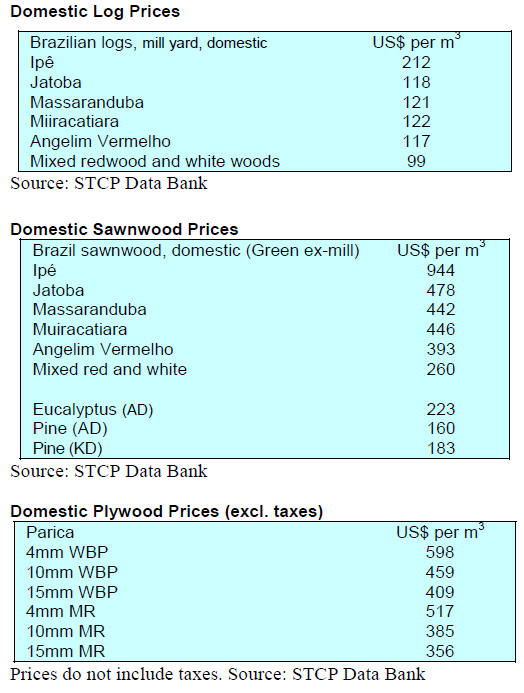
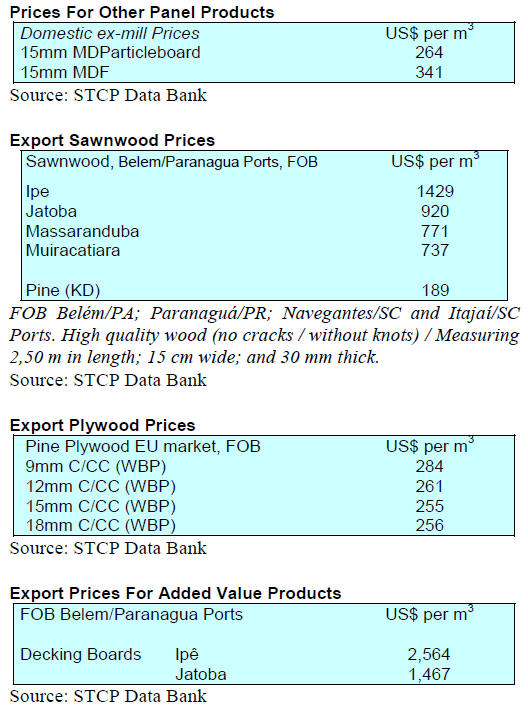
9.
PERU
Peruvian entrepreneurs visit LIGNA 2017
For the first time Peruvian entrepreneurs from the timber
sector in Peru visited LIGNA 2017. This exhibition offers
an opportunity for visitors to update on forestry and
processing technologies, sawmill technology, solid wood
working, developments in the wood energy sector and
machinery and equipment.
One of the Peruvian group commented that it was
interesting to see firsthand progress in production
innovations and technologies.
Loreto Region initiates new process for allocating
concessions
The Forestry Development Executive Board has reported
that the Loreto Region has some 1.2 million ha. of forest
that could be made available to concessionaires and that a
new fast track allocation process will be available.
It was also reported that the regional government of
Ucayali is adjusting the way it manages concession
allocation based on guidelines provided by Serfor. They
are also providing technical advice to the regional
governments of Loreto, Ucayali, Madre de Dios, Huánuco
and San Martín on the guidelines and other technical
issues.
In related news, the Forestry Development Executive
Board presented a progress report on the National Protocol
to Standardise Criteria for Evaluation of Timber Forest
Resources. This was agreed by the forestry authority, the
Forest and Wildlife Resources Monitoring Agency
(Osinfor), regional forestry agencies and civil society.
Work begins on draft National Forestry Plan
The National Forestry and Wildlife Service has begun
drafting a National Forestry and Wildlife Plan (PLNFFS),
a guiding document for the next 10 years.
The development of the PLNFFS will focus on
“participation, commitment and a vision of the future for
the benefit of present and future generations”, said Vice
Minister Quijandría.
The development of the plan is seen as vital as the
contribution of the forestry sector to the Peruvian
economy as reflected in GDP barely achieves 0.9%.
The aim of the national plan is to increase this contribution
through competitive and sustainable activities which will
lead to greater and well distributed wealth as well as better
living conditions in the people.
The PLNFFS aims to provide a strategy for public and
private action in the forestry sector.
